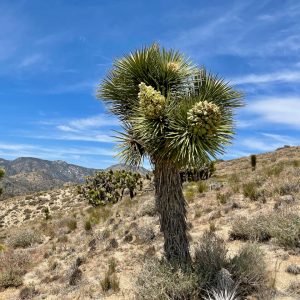Ongoing projects
The Yoder Lab studies how coevolution between interacting species helps to create and maintain biodiversity, and how intimate species interactions can help or hinder adaptation to other factors, including changing climate.
Mutualism at the limits
Yuccas like Joshua tree are pollinated by highly specialized yucca moths. Female yucca moths carry pollen from flower to flower in tentacle-like mouthparts — which no other insects possess — and actively apply pollen to the receptive surface of the floral stigma. The moths do this because they are entirely reliant on yucca flowers as a nursery and a food source. Before pollinating a flower, each female moths lays eggs inside it using a needle-like ovipositor. As the pollinated flower develops into a fruit, her eggs hatch and the larvae eat some of the seeds developing alongside them. Yucca moths have short adult lifespans, so their only substantive food source is yucca seeds — and yuccas have no other effective pollinators. Eastern and western Joshua trees (Yucca jaegeriana and Y. brevifolia) are pollinated by two different yucca moth species, and they differ in floral measurements that are important for the interaction with their pollinators.


In addition to this highly specialized mutualism, Joshua trees are adapted to a wide range of challenging desert environments, from the margins of Death Valley to mountainside pine forests. As part of the Joshua Tree Genome Project, we are working to understand what genes underlie Joshua tree’s adaptation to the extreme climates in which it grows. We can use this information to understand whether adaptation to specialized pollinators helps or hinders adaptation to climate, and whether pollinators or climate have done more to shape the diversity of Joshua tree populations. With support from the National Science Foundation and Revive & Restore Wild Genomes, and in collaboration with biologists at Willamette University, the Universities of Connecticut and Alabama, and the U.S. Geological Survey, we are identifying traits that help Joshua tree seedings survive heat and drought stress, and mapping genetic variants that underlie these climate-adaptive traits.
Student research opportunities in field collection of genetic samples, data collection in experimental common gardens, DNA extraction and sequencing library preparation, bioinformatics
Key publications
Godsoe W, JB Yoder, CI Smith, and O Pellmyr. 2008. Coevolution and divergence in the Joshua tree/yucca moth mutualism. The American Naturalist 171(6): 816-23. doi.org/10.1086/587757. Full text (PDF, 447KB).
Yoder JB, CI Smith, DJ Rowley, WKW Godsoe, CS Drummond, and O Pellmyr. 2013. Effects of gene flow on phenotype matching between two varieties of Joshua tree (Yucca brevifolia; Agavaceae) and their pollinators. Journal of Evolutionary Biology. 26(6): 1220-33. doi.org/10.1111/jeb.12134. Full text (PDF, 595KB). Data on Dryad, doi 10.5061/dryad.369q9.
Coevolution and diversification

The coevolution of intimately interacting species has probably been important in the diversification of life on Earth. Coevolution occurs when two species interact in such a way that each species exerts natural selection on the other — examples include mutualisms like Joshua tree and its yucca moth pollinators, but also antagonistic interactions like hosts and parasites, or plants and specialized herbivores. Groups of organisms like butterflies and beetles that often live in close association with one species of host plant are thought to have evolved their tremendous diversity as a result of coevolution with their hosts, but how coevolution is linked to the formation of new species remains poorly understood.
Coevolution should create particular patterns in the genetic diversity of the two interaction species, and we can test for these patterns to better understand when and how coevolutionary selection may contribute to the origin of new species. We’re assembling data from different kinds of species interactions in habitats across the globe to reveal the link between coevolution and evolutionary diversification.
Student research opportunities in scientific literature searching, data extraction and management, population genetic data analysis, meta-analysis

Key publications
Yoder JB, A Dang, C MacGregor, and M Plaza. 2022. Plant-associate interactions and diversification across trophic levels. Evolution Letters. doi.org/10.1002/evl3.296
Yoder JB, G Gomez, and CJ Carlson. 2020. Zygomorphic flowers have fewer potential pollinators. Biology Letters. 16(9): 20200307. doi.org/10.1098/rsbl.2020.0307. Data on Dryad, doi.org/10.5061/dryad.gxd2547j3. Full-text preprint on bioRxiv, doi.org/10.1101/743872
Hembry DH, JB Yoder, and KR Goodman. 2014. Coevolution and the diversification of life. The American Naturalist. 184(4): 425-38. doi.org/10.1086/677928. Full text (PDF, 436KB)
Modeling species habitat needs

Species distribution models (SDMs) are a widely used method for understanding the habitat needs of species when direct experimental testing is not possible. SDMs use geo-referenced observations of locations where a species is present, and compare them to locations where the species is absent to identify habitat conditions in which the species is likely to be found. SDM results can be used to predict where undiscovered populations of a species may be located, and to project species’ geographic ranges backwards in time or forwards in time — to estimate how a species may be impacted by climate change. A new line of research in the lab is developing an approach for species distribution modeling that can predict not only whether a species is found in a particular set of habitat conditions, but what conditions the species needs to have a healthy, growing population. We’re working with crowdsourced observations of flowering plants drawn from the iNaturalist platform to build and test this new approach using a suite of machine-learning methods implemented in the open-source R data analysis environment.
Student research opportunities in annotation of raw crowdsourced observations, data management and organization, machine-learning model fitting and evaluation
Key publications
Yoder JB, AK Andrade, LA DeFalco, TC Esque, CJ Carlson, DF Shryock, R Yeager, and CI Smith. 2024. Reconstructing 120 years of climate change impacts on Joshua tree flowering. Ecology Letters, 27, e14478. doi.org/10.1111/ele.14478 (open access)
Godsoe WK, E Strand, T Esque, CI Smith, JB Yoder, and O Pelmyr. 2009. Divergence in an obligate mutualism is not explained by divergent climatic factors. New Phytologist 183(3): 589-99. doi.org/10.1111/j.1469-8137.2009.02942.x. Full text (PDF, 3.7MB).